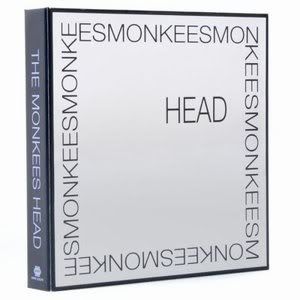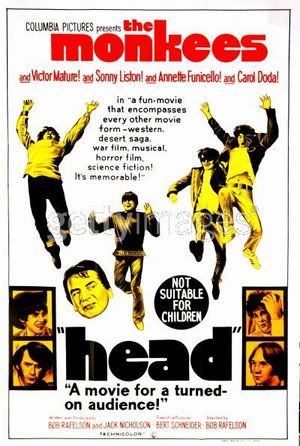For many years, the history of the Monkees has been painted to suggest that the real turning point in their musical career came with 1967’s Headquarters, their third album but the first to feature the derisively-nicknamed Prefab Four — Micky Dolenz, Davy Jones, Mike Nesmith, and Peter Tork — as the predominant musicians and songwriters. It’s arguable, however, that they experienced an equally pivotal moment when they released their lone feature film endeavor: “Head,” which hit screens in 1968 and blew the minds of everyone who saw it…some in a good way, some not.
If one wanted to make the tired but inevitable comparison between the careers of the Beatles and the Monkees, then let’s say that the 58 episodes of “The Monkees” served as their equivalent of “A Hard Day’s Night” and “Help!” Ironically, they switched places with their next projects: the Beatles followed those films with a television program (“Magical Mystery Tour”), while the Monkees finally left the small screen behind for their belated upgrade to the world of motion pictures.
Both productions were well-intentioned attempts to step outside the box and do something different, neither were received with what you’d call wild enthusiasm, but while the Beatles managed to recover from their creative fiasco, it proved to be the beginning of the end for the Monkees. By the time the group’s next album, Instant Replay, hit stores in 1969, Peter Tork had left the band, ostensibly due to the lack of a proper group dynamic…or, as he puts it in the liner notes for Rhino Handmade’s deluxe edition of the Head soundtrack, “I did what I could, but I didn’t feel like there was any reason for me to be there anymore. It wasn’t what I wanted. I wanted to be in a group and nobody else did.”
While it must be remembered that Tork had a tendency during this era to drive others crazy in the studio with his hippy-dippy requests (the saga of his song “Lady’s Baby,” from the sessions for The Birds, The Bees, & The Monkees, is well documented), which means that he may well have been as much at fault for the situation as anyone else, there’s no denying that the Monkees were making some of the most interesting music of their career at the time of his departure. Maybe not the best, and certainly not the most commercial, but whether you dig what they were doing or not, you have to admit that they were taking risks and defying expectations.
It might not have been great for their career, but it did wonders for their credibility.
The soundtrack of “Head” begins with the brief bit of psychedelia that is “Opening Ceremony,” which, while unnecessary when taken out of context, serves to set the feel of the record as it segues seamlessly into the the film’s theme song. Although not a commercial success as a single, “Porpoise Song,” written by Gerry Goffin and Carole King, is one of the most gorgeous moments of the Monkees’ career and has gone on to be covered by the Church, the Wondermints, and the Polyphonic Spree, among others. Be prepared when listening to the soundtrack, however: it can be jarring when you’re expecting a fadeout and instead abruptly find yourself on the next track, “Ditty Diego – War Chant,” a mocking revision of the Monkees’ theme song.
Hey, hey, we are the Monkees
You know we love to please
A manufactured image
With no philosophies
Anyone who listens to this and can’t recognize that the Monkees were trying to use “Head” to break the bonds of public perception must be incapable of perceiving sarcasm.
“Circle Sky” features an unstoppable riff from Mike Nesmith, and Peter Tork’s two contributions to the soundtrack – “Can You Dig It” and “Long Title: Do I Have To Do This All Over Again” – are arguably the two best Tork compositions that ever made it onto a proper Monkees release. Neither Dolenz nor Jones brought any songs to the table, but Davy delivers a solid performance of Harry Nilsson’s “Daddy’s Song” (he always did have a way with Nilsson’s material), and Micky…well, hell, he’s all over this record: in addition to “Porpoise Song” and “Can You Dig It,” he also fronts the group for “As We Go Along,” written by Carole King and Toni Stern.
When I reviewed The Birds, the Bees & the Monkees, I wrote, “The fact of the matter is that — setting aside the soundtrack to ”Head” — it’s easily the least of the albums recorded by the band as a foursome.” I still stand by what that statement implies about the quality of Head as an album, but I’ll offer a caveat: if you take the actual Monkees songs from the soundtrack and listen to them consecutively, you’ve got some pretty kick-ass material. It’s the additional material that drags down the proceedings…or, at least, it does for me. Whoever wrote the Wikipedia entry for Head clearly feels otherwise, saying, “The soundtrack album intersperses the six proper songs with bits of Ken Thorne’s incidental music, dialogue fragments and oddball sound effects, for an overall effect surprisingly close to (Frank) Zappa’s Lumpy Gravy.” Maybe they’re right: I’ve never been much of a Zappa fan, so that would possibly explain why I love the songs but have never warmed to the album as a whole.
As usual, Rhino Handmade has done right by Monkees fans with this reissue: the 3-CD deluxe edition of the “Head” soundtrack is yet another awesome piece of work, offering archival advertisements and photographs, a thick booklet which features a history from Andrew Sandoval – “We Hope You Like Our Story (Although There Isn’t One): The Making of Head and the Unmaking of The Monkees” – as well as an essay by Rachel Lichtman entitled “Can You Dig It? Philoso-phees on the Phenomenon of Head,” a 7″ single containing instrumental mixes of “Porpoise Song” and “As We Go Along,” and even a “Head” button.
When it comes to the outtakes and rarities of the set, there’s no question that Rhino has come up with a ton of material, but unlike The Birds, the Bees & the Monkees, this is a release that’s going to be pretty hard to sell to anyone outside of the band’s diehard fans, as the additional material consists predominantly of alternate mixes. There is, however, a four-pack of live Nesmith compositions, including a stellar version of “Circle Sky,” along with a studio version of Tork tackling “California, Here It Comes” (otherwise known as “California, Here I Come”). The third disc, meanwhile, is a radio special from 1968 which intersperses portions of songs from the soundtrack with Davy’s responses to questions which the DJs of the era would be cued to ask, thereby creating the effect of an interview. Again, cool for the fans, but even they’re not likely to spin it more than once or twice.
So here’s the reality of the situation: any Monkees fans who want to keep seeing deluxe editions of the group’s albums should buy the deluxe edition of Head. If you fall into that category, then you won’t be disappointed by what you get. For those of you who are curious about these songs I’ve cited but can’t see spending the money…hey, I don’t blame you, but I will recommend that you go buy Music Box, a 4-CD set which provides a history of the Monkees’ entire career – yes, including Pool It! and Justus – and, in doing so, provides you with all seven Monkees songs from the Head soundtrack: “Porpoise Song, “Ditty Diego – War Chant,” “Circle Sky,” “Can You Dig It,” “As We Go Along,” “Daddy’s Song,” and “Long Title: Do I Have To Do It All Over Again.” Man, you’ve really got to respect a label that actually assists you in not buying one of their releases…
One last note: in case you haven’t heard, “Head” is getting the Criterion treatment on DVD. The only bad thing is that, as it stands right now, it’s only going to be available as part of a box set entitled “America Lost and Found: The BBS Story,” which spotlights many of the notable films which emerged through BBS Productions. Fortunately, there’s an up side: the other films in the box set are “Easy Rider,” “Five Easy Pieces,” “Drive, He Said,” “A Safe Place,” “The Last Picture Show,” and “The King of Marvin Gardens.” I have to admit, though, that even as a Monkees fan, my first thought after reading those titles was, “Geez, what the hell is ‘Head’ doing in here?”







Comments